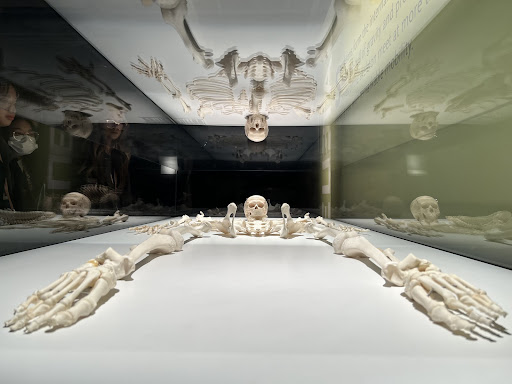‘Bodies: The Exhibition’ is morally wrong
Controversy surrounding this longstanding exhibition is nothing new

The German anatomist Gunther von Hagens technique of preservation has raised eyebrows from spectators and investigators alike.
January 26, 2023
For the past week, I’ve been starving – I haven’t been able to eat a lot of meat, which is unashamedly a large part of my diet. Every time I bite a piece of meat, I suddenly lose my appetite and I spit it into the trash. Although I’ve been improving by distracting myself with endless YouTube videos during dinner, it’s been a challenge trying to consume a whole meaty meal.
I lost my appetite for meat after going to Bodies: The Exhibition at the Luxor. Admittedly, I did little research before embarking on the field trip, so I was completely unaware that the entire premise of the exhibition was the fact that all the samples and models were actual people.
The exhibition focuses on a process called “plastination,” in which human cadavers are positioned and preserved in a non-toxic process for the “benefits of anatomy.” The exhibition is separated into various rooms dedicated to different bodily systems, and features several diseased organs and figures. The demonstrations of these cadavers in various action poses are meant to highlight the intricacies and complexities of muscles, tissues and diseases within the human body, offering a completely new experience for anatomy students who are used to fake plastic models.
At first, I could handle what I encountered, but it all changed when I glimpsed a headless adolescent with their skull exposed and their facial surfaces still intact. For a good 15 minutes, tearful emotions suddenly arose as I stared blankly at the closed eyelids of the young child and their missing brain, reminding me of my brother whom I’ve dedicated my life to. The specimen made me question the integrity of the entire exhibition and prompted me to conduct some research of the exhibition.
All the bodies came from China, as explained by the tour guide. However, the cause of death and identities were purposefully kept from the patrons. Further internet research shows that other Bodies exhibitions have featured executed political prisoners and trafficked human cadavers, as proven by executives and researchers. The Dalian Medical University Biology Plastination Ltd., which is where most of the specimens came from, was proven to have collaborated with Chinese police to acquire cadavers.
Not only that, but China is notorious for their human rights abuses, political imprisonment, and plentiful executions. It isn’t insane to question the legitimacy of these cadavers – after all, if a country’s government is currently committing genocide, a globally forced organ harvesting operation committed by them is totally plausible.
But even if the bodies are legitimate volunteers, the entire operation is just too immoral. Having human remains on display for visitors to gawk over isn’t morally right. These people had legitimate lives, and I doubt any of them lived and died just to have drunk casino goers snap a photo of their insides and possibly spill a beer on their forever-frozen bodies. Realistically, even if it claims to be for “educational purposes,” they should reserve these types of experiments for a medical institution, not the inside of a casino. Although the anatomy of the human body is intriguing and awareness of diseases is important, it doesn’t require the petrified head of a child or the fetal remains of a deceased pregnant woman’s womb to be front and center for general observation.
It probably won’t be easy to eat for at least another week without the petrified remains of a child bobbing around in my mind. At least the exhibition gave me an understanding of how important health is, but morally speaking, spending two hours with beheaded children and executed Chinese prisoners wasn’t necessary.









James Weir • Nov 3, 2024 at
I would concur with the author of this article.
Angel • Sep 9, 2024 at
Thank you for sharing your thoughts and research on this. I had these Shane l same thoughts when seeing the exhibit advertised on social media. I looked up the photos and cannot help but think about the lives and hopes and dreams of all these individuals. How did they die? Was a big question. If anything this exhibit has made me more aware of the worth of life and respect for it even after death. I too wish more people would have this reverence for humankind. I also noticed that there were a lot of Chinese people in this and it made me even more concerned about the cause of death. Were these Christians? I cannot comprehend horrible actions even in the name of science. It feels like it mocks creation and kinda like how serial killers keep souvenirs. Just wrong!
Morally wrong!
Ash • Jul 8, 2024 at
My partner brought this concept up to me recently, explaining to me that he saw an exhibit exactly like this when he was in high school (c. 2011) and my very first thought was “They got the bodies from China? Was there proof of consent?” which led to me finding this article because he just thought the exhibit was cool and was explaining all the “cool stuff” he saw while I was having an existential crisis for all those people that might not have consented to being a grotesque spectacle for anyone to see, plus the idea of other people using human remains so disrespectfully for profit (behind the guise of medical education) messed me up. I know that organ trafficking happens and that is already disgusting enough, when it happens in the shadows. But this is just as sick to me as those psychos that skin animals for their fur only. I mean, if they consented and there was irrefutable proof of that consent (like the whole US organ donor thing) then go off I guess. The lack of clear consent makes the entire thing dubious and honestly makes my skin crawl. Your entire piece was very well done. I am glad I found this.
noneof yourbusiness • Jul 5, 2024 at
Probably one of the best exhibits I’ve ever seen.
Everybody crying about “morals” that is your problem. You all are simply trying to forced your morals onto the rest of us. Gotta love organized religion !!
There is nothing unethical about the show. It provides a detailed insight into anatomy most people do not normally get to see or know about. It has a shock value factor (yeah the hairs on your neck raise up at first when you walk in).
Doing some research shows some lack of inromation about a controversy surrounding the acquisition of the bodies but this could easily be resovled by the different companies that do these show providing public transparency into where they source their bodies from.
Other than that go see the show if you get a chance !!
Matthew Yeomans • May 21, 2024 at
Going vegan for me was because seeing what happens to animals. Maybe not eating animal products is the answer for you.. maybe your conscience is saying something to you.
Jeff Reynolds • May 11, 2024 at
I enjoyed the exhibit.
Lea Hernandez • Jun 13, 2023 at
To desecrate a human body, no matter what evil acts a person did during his earthly life, is still morally wrong.. value to the sanctity of life. well written.
Jane Smith • May 24, 2024 at
I absolutely agree with this. I hope more people continue to speak out about it as the exhibition continues to be shown. Von Hagens has absolutely no regard for human life. These people have been reduced to objects, and some are in sexual positions on top of that. I hope there can be some way to test for DNA so these people can find justice.
Jana Peterson • Oct 6, 2024 at
I have a good friend whose son was murdered by his Grandmother and it was covered up. When he died she was not allowed to see him and in her grief signed some papers. She found her son in the Body Exhibit. It is without question him. A mother knows her child. Her sons Father and wife are tied to the company that owns this. It’s one of the most sick and evil things I have ever seen. Can you IMAGINE knowing people are gawking at your son’s naked dead body every day? 13 years I’ve been watching her devastation and this is where it ended up. You should know if you go that there are MANY accounts of same. Grotesque.